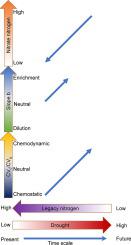Journal of Hydrology ( IF 6.4 ) Pub Date : 2023-05-30 , DOI: 10.1016/j.jhydrol.2023.129750 Ji Liu, Doerthe Tetzlaff, Tobias Goldhammer, Songjun Wu, Chris Soulsby

|
Stream nitrate nitrogen (NO3) concentrations and concentration-discharge (C-Q) relationships are key indicators of water quality. However, their long-term variability and response to climate change in large-scale catchments are still poorly understood. Here, we report a synoptic survey and long-term observations (2000-2021) in the Spree catchment (10,105 km2), Germany, to identify the spatial-temporal patterns in stream NO3 concentrations and C-Q relationships, as well as the underlying environmental drivers. We found that in the context of gradual reduction of nitrate inputs, the stream NO3 concentrations had a decreasing trend, but showed different magnitudes at different spatial scales (-0.01-0.48 mg L-1 yr-1). In the upstream parts of the catchment - with a high proportion of farmland - high levels of stream NO3 concentration remained with a risk of eutrophication due to the large nitrogen legacy. Especially in winter, stream NO3 concentrations were much higher due to the groundwater export with high NO3 concentrations, a decreased dilution effect of rainfall and vegetation uptake became clear. Consequently, the large nitrogen legacy in the upper catchment resulted in NO3 concentrations not significantly changing with streamflow and showing chemostatic behavior. This was different from NO3 dynamics in the mid- and lower-catchment areas, which were positively related to streamflow, showing a chemodynamic behavior. Further, we found the export patterns (i.e. enrichment vs. dilution) of stream NO3 concentrations strongly correlated with the export regimes (i.e. chemostatic vs. chemodynamic), which were also affected by drought conditions. This is probably due to the decrease in stream depth which would enhance benthic removal leading to a decrease in stream NO3 concentrations. Reduced hydrological connectivity leads to higher spatial heterogeneity of residual NO3 in soil and drainage water, which will result in chemodynamic behavior of stream NO3 concentrations. After rewetting, the export of these high NO3 concentration in soils led to elevated stream NO3 concentrations, resulting in a positive correlation with streamflow. Our work revealed significant heterogeneity in stream NO3 concentrations and C-Q relationships at different spatial-temporal scales in large catchments. Critically, current stream NO3 concentrations and C-Q relationships are likely to respond strongly to future drought, leading to challenges for future land and water management.
中文翻译:

量化复杂、高度管理、对干旱敏感的河流系统中 NO3 浓度和浓度-流量关系的变化和趋势
溪流硝态氮 (NO 3 ) 浓度和浓度-流量 (CQ) 关系是水质的关键指标。然而,人们对它们在大范围流域的长期变异性和对气候变化的响应仍知之甚少。在这里,我们报告了德国 Spree 流域(10,105 km 2)的天气调查和长期观测(2000-2021 年) ,以确定流 NO 3浓度和 CQ 关系的时空模式,以及潜在的环境驱动因素。我们发现,在硝酸盐输入量逐渐减少的背景下,NO 3浓度呈下降趋势,但在不同空间尺度(-0.01-0.48 mg·L -1年-1 )。在集水区的上游部分 - 农田比例很高 -由于大量的氮遗留物, NO 3浓度仍然很高,存在富营养化的风险。尤其是在冬季,NO 3浓度高得多,因为地下水输出的 NO 3浓度高,降雨和植被吸收的稀释作用减弱变得明显。因此,上游集水区遗留下来的大量氮导致 NO 3浓度不会随水流发生显着变化,并表现出恒化行为。这与 NO 3不同中下游流域的动态变化与径流呈正相关,表现出化学动力学行为。此外,我们发现流 NO 3浓度的输出模式(即富集与稀释)与输出机制(即恒化与化学动力学)密切相关,后者也受到干旱条件的影响。这可能是由于水流深度的减少会增强底栖生物的去除,从而导致水流中 NO 3浓度的降低。水文连通性降低导致土壤和排水水中残留 NO 3的空间异质性更高,这将导致流 NO 3浓度的化学动力学行为。再润湿后,这些高 NO 3的出口土壤中的浓度导致溪流 NO 3浓度升高,从而与溪流流量呈正相关。我们的工作揭示了流域 NO 3浓度和 CQ 关系在大流域不同时空尺度上的显着异质性。至关重要的是,目前的流 NO 3浓度和 CQ 关系可能会对未来的干旱做出强烈反应,从而给未来的土地和水资源管理带来挑战。


























 京公网安备 11010802027423号
京公网安备 11010802027423号